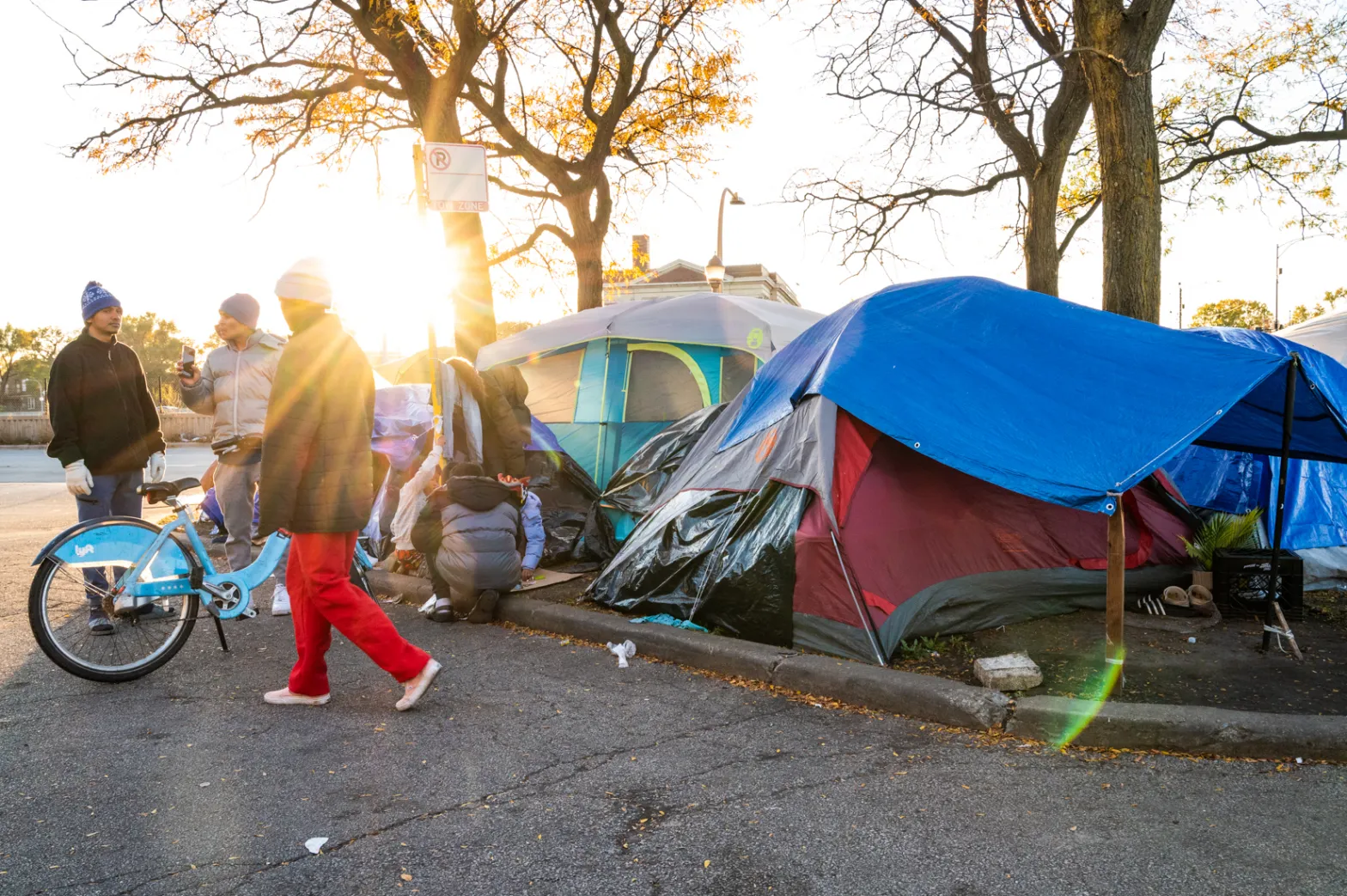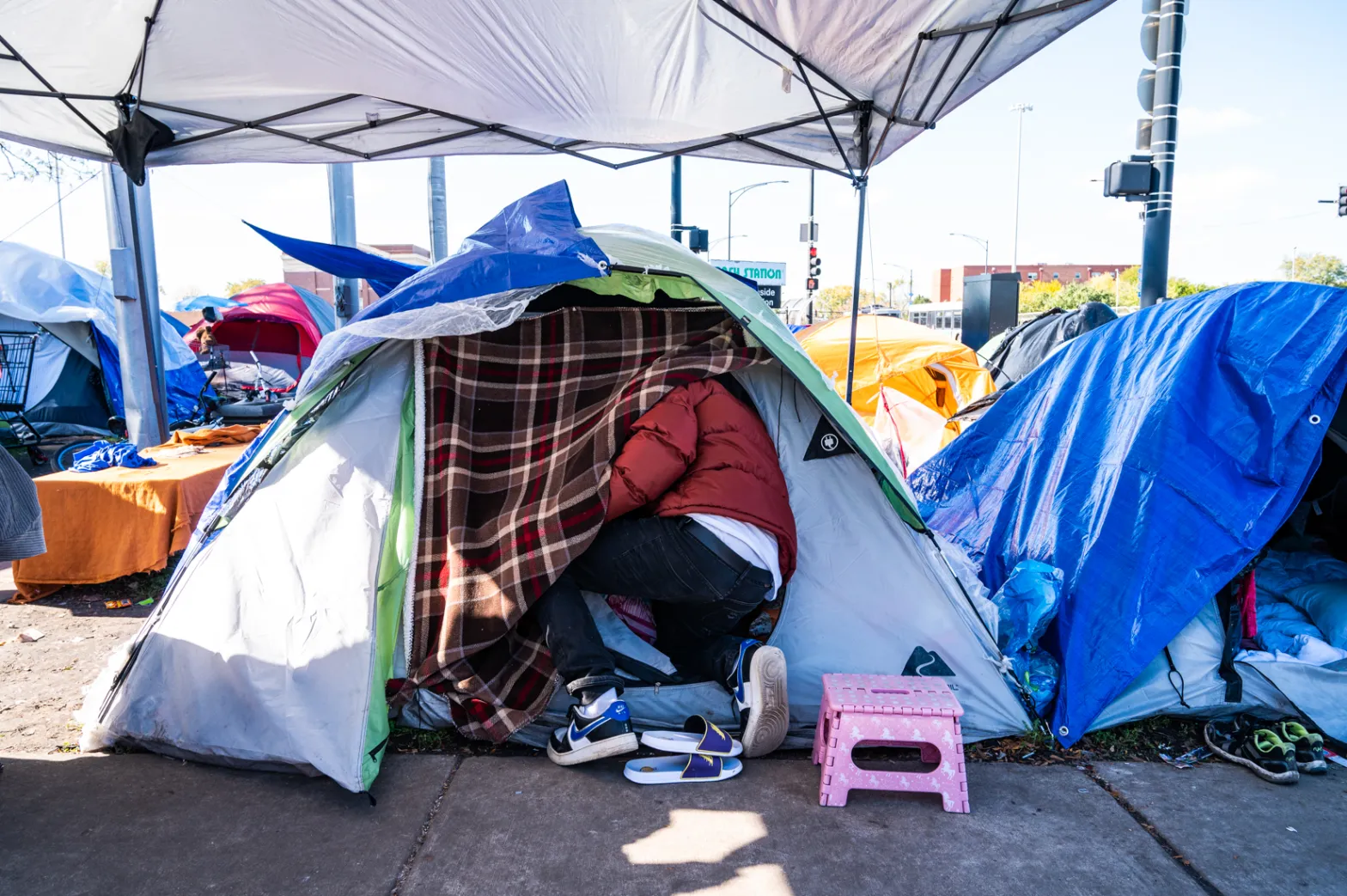 Colin Boyle / Block Club Chicago
Colin Boyle / Block Club ChicagoVolunteers fear the shelter limit is going to create a “new sh-tshow” when folks are forced to leave — and push more people into homelessness.
This story was originally published in Block Club Chicago, a nonprofit newsroom focused on Chicago’s neighborhoods. Sign up for its free daily newsletter.
CHICAGO — A limit on how long migrants can stay in temporary city-run shelters went into effect Friday, in what officials say is part of an attempt to accelerate resettlement efforts for thousands of asylum seekers living in Chicago.
Mayor Brandon Johnson announced the 60-day limit on Wednesday as the “next iteration” of the city’s new arrivals mission. The policy change comes as the state of Illinois announced on Thursday they will spend an additional $160 million on housing and resettlement services for migrants ahead of plunging winter temperatures.
All migrants who enter city shelters starting Friday will be limited to 60-day stays, according to a press release from the Mayor’s Office. People already in shelters will be subject to varying timelines for when the limit kicks in.
Want to receive stories like this in your inbox every week?
Sign up for our free newsletter.

If migrants are still living in city shelters after the 60 days run out, they will have to return to the city’s “landing zone” — the area near Downtown where most buses carrying migrants drop them off — to make a new shelter request. Extensions to stay in a shelter beyond 60 days will only be granted in “extenuating circumstances” like a medical emergency or severe weather, officials said.
“There may be other circumstances that would enable us to give them an extension, but we are really looking to use those only in the most needy cases and others will have to go back to the landing zone,” Beatriz Ponce De León, the city’s deputy mayor of immigrant, migrant and refugee rights said during a press briefing Friday afternoon.
“This helps us to open bed space at our existing shelters even as we continue to work on opening the base camp locations and identifying new brick-and-mortar shelters.”
The timeline for the 60-day limits, according to the city:
- New arrivals who entered a shelter in 2022 will receive a 60-day notice beginning Friday.
- New arrivals who entered a shelter between Jan. 1 and July 31 will begin receiving 60-day notices on Dec. 4.
- New arrivals who entered a shelter between July 31 and Nov. 16 will begin receiving 60-day notices on Feb. 1, 2024.
- All new arrivals to a shelter on or after Friday will receive a 60-day notice upon intake.
- About 50 people across three shelters have been in the shelter system since 2022, Department of Family and Support Services commissioner Brandie Knazze said Friday.
As of Friday morning, more than 12,000 migrants were living in 25 temporary shelters across the city. About 1,600 asylum seekers continue to be housed at police stations, with almost 600 at O’Hare International Airport, according to city data.
City and state officials say the new shelter limits will be accompanied by ramped-up case management and resettlement efforts in each shelter, although a rental assistance program set up through the state will no longer apply to new arrivals entering the shelter system.
City officials say they’ve been able to help more than 7,000 asylum seekers into permanent housing since August 2022.
“We’re putting some restrictions and some boundaries and parameters in place. But the ultimate goal is to make sure that these families are treated with dignity,” Johnson said Wednesday.

Gov. JB Pritzker on Thursday said new state spending will fund the creation of a centralized intake center for migrants coming to Chicago as well as a winterized shelter that can house up to 2,000 people. Funds will also go toward ramping up “wraparound services” to expedite permanent resettlement for asylum seekers.
The state is partnering with New Life Centers of Chicagoland to deploy a team to the Chicago bus landing zone “to ensure every new arrival is supported in a choice to seek alternative arrangements outside the city shelter system,” Pritzker said.
That includes migrants who seek to travel to a different destination than Chicago. With new staff at the landing zone, they’ll be able to better facilitate onward movement, an effort that could reduce the shelter population by 10 percent, officials said.
“Immediate support” for migrants at the landing zone will also include heated tents and emergency clothing and food, officials said.
The city is also planning to cite and ticket bus companies that skirt city curfews and unloading rules when dropping migrants off in Chicago. Buses in recent months have arrived throughout the night and without prior notice, leaving city officials scrambling to accommodate asylum seekers.
“We really struggle with that because rogue buses essentially put individuals seeking asylum in danger, and especially with you know, the winter weather, we can’t allow that type of behavior to happen when you’re going to put people in these types of conditions and not having the safety procedures,” Johnson’s deputy chief of staff Cristina Pacione-Zayas said Friday.
Read More of Our Coverage
While resettlement services for migrants are being expanded thanks to the new state dollars, a rental assistance program will no longer be available for any migrants who enter the city’s shelter system starting Friday.
Instead, the state-run Asylum Seeker Emergency Rental Assistance Program will only be available going forward to those currently in a shelter, and will last for three months instead of six.
Kirstin Chernawsky with the Illinois Department of Human Services said on Friday that’s to make sure the remaining dollars in that program last for as long as possible.
“The decision was made that for all folks that are currently in shelter who had some level of expectation that they may receive that emergency rental assistance, it would be better to stretch those dollars to reach everyone that’s currently in the shelter system and then allow folks that are making the choice to come to Chicago versus another location to know exactly the benefits that they will be receiving when they get here,” she said.
Legal assistance, help finding housing, school enrollment and other services will still be available to asylum seekers who have yet to enter the city’s shelter system.

‘It’s Not Reasonable’
Several volunteers who have worked with migrants across the city in recent months are skeptical of the 60-day limit and said Friday they’d like better communication about the policy change from the city.
Katharina Koch, a lead volunteer helping migrants at the Jefferson Park (16th) Police District station, said the 60-day notice sounds reasonable in theory but does little to actually help migrants find housing, especially with the onset of winter.
It also does not address the problems with the city’s shelter system, including inadequate staffing and resources, that have made the shelters unattractive to many migrants, she said.
Koch has heard from families in city-run shelters that learning English, getting essential care items, access to odd jobs and legal aid — things they received from volunteers and neighbors while at police stations — is difficult.
“It becomes harder and harder for us volunteers to convince people to actually go into shelters, which has been a huge problem at many stations, and actually [the Office of Emergency Management and Communication] is begging us volunteers to make shelters sound more attractive,” she said. “The most attractive thing that we felt we could message was the housing help, which is now about to run out.”
With housing vouchers running thin and minimal legal aid access to get work permits, migrants are unable to secure a job to pay for housing, which creates a cycle that needs to be interrupted, Koch said.
“Kicking people out of shelter in the beginning of winter is also a creation of homelessness,” Koch said. “If we don’t talk about these root causes of why people are not able to get into housing, then we’re not really helping them.”

Lety Pigoni, a volunteer with Community Care Collective 33 helping migrants at the Albany Park (17th) Police District station, agreed, saying the timeline doesn’t make sense.
“It’s not reasonable, especially during winter,” Pigoni said.
Volunteers said they want more clarity from the city on how the policy will work, how extensions for families will be determined and what will happen to those who get kicked out of the shelter system.
Some say it’s a disappointing step backward that could lead to even more work for volunteers already stretched thin.
“We have to realistically prepare ourselves for unhoused encampments of migrants where we will have to do this work again and having to build up these structures again of showers, food, provisions,” Koch said. “It might be the introduction of a new sh-tshow, which is really disappointing.”
When asked by a reporter on Friday what would happen to migrants if they refuse to leave a shelter, Knazze said she wasn’t sure because “we have not gotten there yet.”
“The goal is that people will leave and understand the policy, and they will be coached and they will have support from their residential aides and their case managers,” she said.

Bring power to immigrant voices!
Our work is made possible thanks to donations from people like you. Support high-quality reporting by making a tax-deductible donation today.
